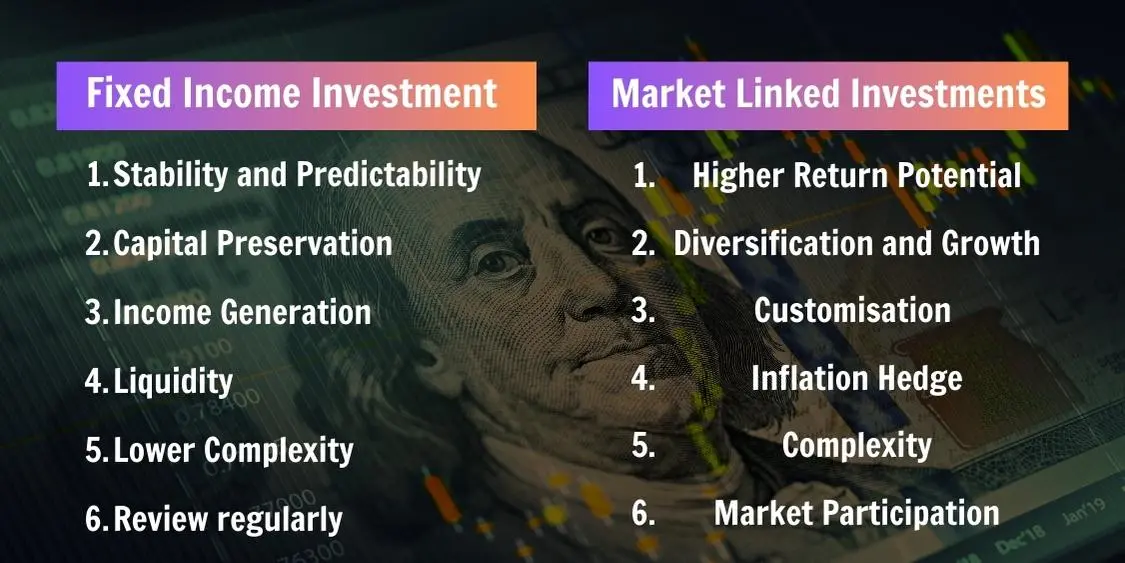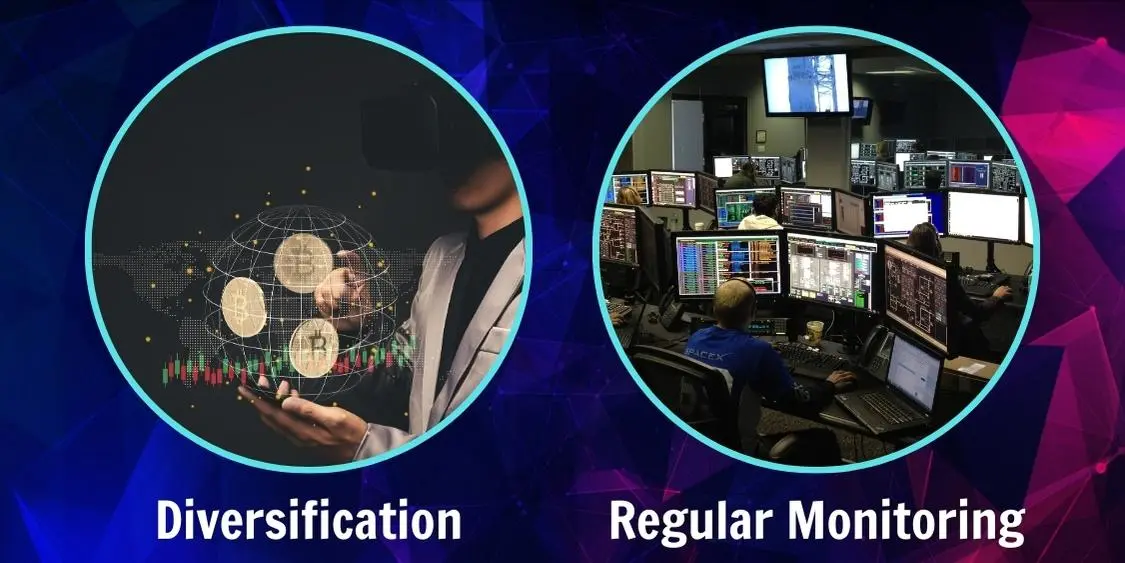Are you struggling to decide where to diversify your portfolio? Market-linked investments portfolio could be a powerful tool to consider. Our guide will demystify these investment opportunities, outlining the benefits they offer like high returns and flexibility, as well as the risks including market volatility and potential loss.
So why wait? Let’s delve into how market-linked investments options can help fuel your financial growth!
Key takeaways
●Market-linked investment offers the potential for high returns and flexibility to investors.
●These long term investments allow access to a wide range of asset classes, providing opportunities for growth and diversification.
●However, market volatility and the potential for loss are important risks that need to be considered before investing in market-linked instruments.
●When choosing between fixed income and market-linked investments, it's crucial to assess your financial goals and understand your risk appetite.
What are Market Linked Investments (MLIs)?
MLIs mix old-style government bonds with return potential. This return links to how well other assets perform. The assets can be many things, like market indices or foreign exchange.
Even individual stocks or interest rates can work too! Like other corporate bonds, Market-Linked Investments are issued for fixed terms, such as one to five years, and remain subject to issuer credit risk.
Instead of paying you a traditional interest coupon, Market-Linked guaranteed Investments certificates provide you with exposure to the depend on the performance of a market index, an individual stock exchange, commodities, foreign exchange, or interest fixed rates.
Market-Linked Investments can be purchased in a new issue offering or in the secondary market. These market-linked investments are great for two reasons.
First, they offer a way to spread out your low risk that might not always be possible with traditional investing methods. Second, these safe investments give you more ways to use and act on your views of the market.
Moreover, investing in this way helps cut down on issues related to money, tax rules, and legal matters by packing different plans into one solution.
Market-Linked Investments also hold a wide range of asset classes like equities and fixed deposits security or investment strategy suited for all types of investors – even if some may not be readily available at first glance! Some might give full protection against losses when there is a dip in the markets while others have the chance for higher returns.
Benefits of Market Linked Investments
Market-linked investments offer the potential for high returns and provide flexibility and liquidity to investors. ULIPs (Unit Linked Insurance Plans) stand out within Market-Linked investments, offering investors a hybrid financial product that combines the benefits of insurance coverage with investment opportunities linked to equity, debt, or hybrid funds, providing potential returns based on market performance.

Potential for High Returns
Market-linked investments can give high returns. They are a way for you to make more money on your savings. For example, Merril Lynch offers these types of plans by Bank of America and others.
These firms use their knowledge to get good results.
Also, these life insurance plans tap into many different asset classes.
Some of them are hard for regular investors to reach. So, you also get access to new ways of making your money grow bigger over time which may lead to higher profits.
Flexibility and Liquidity
Market-linked investments are flexible. You can pick from a wide range of asset classes. This means you do not have to stick to one type of investment products.
Also, these investments give quick access to your money if needed. So, you can put in or take out cash when the need arises without a fuss.
Market-linked investments help reduce stress about money matters and tax issues too. Plus, they open up new chances for investing that an average investor might not find on their own.
These benefits make it easy for individual investors to adapt to their financial needs and market views. Yet, always keep in mind your overall risk level and how soon you will need the money before choosing this kind of specific investment.
Risks of Market Linked Investments
Market volatility and the potential for loss are two major risks associated with market-linked investments.
Market Volatility
Market volatility is an important factor to consider when investing in market-linked investments. It refers to the rapid and significant price changes that occur in the financial markets.
Market volatility can impact the return potential of market-linked investments, as their performance is closely tied to market indices, individual stocks market, commodities, foreign exchange rates, and fixed interest rates.
During periods of high volatility, these investments may experience larger fluctuations in value compared to traditional fixed income securities. This means that there is a higher chance of experiencing losses or gains over short holding periods of time.
Potential for Loss
Market-Linked Investments come with the potential for loss of your initial investment. This means that there is a market risk that you may end up with less money than you originally invested.
It’s important to understand this before investing in these types of investments. While they do offer the possibility of higher returns, there is also the chance that you could lose some or all of your principal amount.
This risk is inherent due to various factors such as market volatility and specific risks associated with underlying assets. Therefore, it’s crucial to carefully consider your risk tolerance and financial goals before deciding whether or not to invest in Market-Linked Investments.
Choosing Between Fixed-Income and Market-Linked Investments
When deciding between fixed-income and market-linked investments, it is important to assess your financial goals and understand your risk tolerance.

Assessing Financial Goals
To make informed investment decisions, it’s important to assess your financial goals. Consider what you want to achieve with your money, whether it’s creating wealth creation, savings scheme for retirement, or meeting specific needs like buying a house or funding education.
Think about the time horizon for each goal and how much risk you’re willing to take. Assessing your financial goals will help determine which market-linked investments align with your investment objectives and risk tolerance.
Remember that these investments offer different levels of growth potential returns and risks, so choose wisely based on what you want to accomplish in the long term.

Understanding Risk Tolerance
Investors have different levels of comfort when it comes to taking risks with their investments. Understanding your risk tolerance is important before investing in market-linked instruments.
Risk tolerance refers to how much uncertainty or volatility you can handle without feeling too anxious or nervous about losing money. It depends on various factors such as your financial goals, time horizon, and income requirements.
By assessing your risk tolerance, you can choose investments that align with your comfort level and avoid potential regrets later on. Keep in mind that market-linked investments come with risks such as market volatility, loss of principal, and uncertain taxable consequences.
Get the latest Structured products, a category within Market-Linked Investment, offer investors tailored annuity with customized risk-return profiles, often linked to the performance of underlying assets such as equities, interest rates, or commodities.
Considerations While Investing in Market-Linked Instruments
When investing in market-linked instruments, it is important to consider factors such as diversification and regular monitoring to mitigate potential risks.

Diversification
Diversification is an important consideration when investing in market-linked instruments. It means spreading your investments across different asset classes, such as commodities, stocks and bonds.
This helps to reduce the risk associated with investing in a single asset class. By diversifying your portfolio, you can potentially benefit from the positive performance of one asset class while mitigating any losses from another.
It’s like not putting all your eggs in one basket – if one investment doesn’t do well, others may make up for it. Diversification can provide stability and principal protect against market volatility.
Equity mutual funds represent one facet of Market-Linked Instruments, providing investors with exposure to diversified portfolios of stocks while aiming to achieve returns corresponding to the performance of the equity markets.
When discussing Market-Linked Instruments, it is crucial to highlight that the Performance of the Underlying plays a fundamental role in determining the returns or outcomes of these investment products.
Regular Monitoring
Regular monitoring is essential when investing in market-linked instruments. It allows investors to keep track of how the underlying asset is performing and assess the potential returns and downside protection offered by these investments.
By regularly monitoring their investments, investors can make informed decisions about their investment time horizon and liquidity needs. It also helps them evaluate their overall risk tolerance and ensure proper diversification within their portfolio.
Monitoring helps investors stay updated with any changes in market conditions that may impact their investment performance, enabling them to take appropriate action if necessary. Therefore, regular monitoring is crucial for staying on top of market trends and making informed investment decisions.
Conclusion
In conclusion, market-linked investments offer the potential for high returns and flexibility. However, they also come with risks such as money market volatility and the potential for loss.
When choosing between fixed income investment and market-linked investments, it’s important to consider your financial goals and risk tolerance. Diversification and regular monitoring are key considerations while investing in these instruments.
Overall, understanding the benefits and risks of market-linked investments can help you make informed investment decisions that align with your investment objectives.
FAQs
MLIs are debt instruments linked to the market performance of an underlying market measure, like an index, with targeted risk and return based characteristics.
Market linked product investment has the potential to generate higher market-linked returns compared to traditional investments savings accounts or fixed-income investments.
Yes, market-linked investment comes with risks such as volatility and the possibility of losing money if the market performs poorly.
The recommended time frame for investing in money market-linked product investment is typically medium to long term (5-10 years) to ride out short-term fluctuations and potentially maximize returns in market linked.
While anyone can invest in these types of products, it is important to consider your risk tolerance, and financial goals, and seek advice from qualified financial advisors before making investment decisions.








